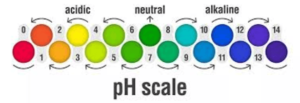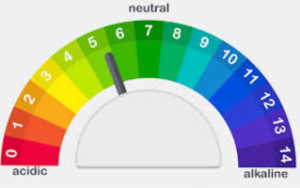Have you ever wondered why some skincare products leave your skin feeling tight and dry, while others make it feel balanced and refreshed? The secret might be in something called skin pH. This often overlooked aspect of skincare plays a crucial role in maintaining healthy, glowing skin.
Today, we’re diving deep into what skin pH is, why it matters, and how to keep yours in perfect balance for optimal skin health.

What is Skin pH?
Your skin’s pH is a measure of how acidic or alkaline it is on a scale from 0 to 14. This scale helps us understand the chemical balance of your skin’s surface, also known as the acid mantle. The term ‘pH’ actually stands for ‘potential of hydrogen,’ referring to the concentration of hydrogen ions present. Anything below 7 is acidic, anything above 7 is alkaline or basic, and a pH of 7 is neutral (like water that is pure).
Healthy skin typically has a pH that falls somewhere between 4.5 and 5.5, making it slightly acidic. This natural acidity is incredibly important because it helps your skin fight off harmful bacteria, pollutants, and other environmental stressors that could potentially damage your skin or cause infections.
When we talk about skin pH, we’re discussing a fundamental aspect of skin biology that affects everything from hydration levels to how effectively your skincare products work. Understanding what skin pH is gives you valuable insight into why your skin behaves the way it does and how you can better care for it.
The Science Behind Skin pH
The slightly acidic nature of your skin isn’t random—it’s a brilliant design by nature. This acidity comes from a combination of:
- Sebum (oil) produced by your skin
- Sweat
- Natural moisturizing factors (NMFs)
- Metabolic processes in your skin cells
Together, these elements create what dermatologists call the ‘acid mantle’—a thin, protective film on your skin’s surface. Think of this acid mantle as your skin’s natural shield. When it’s functioning properly at the optimal pH range, it:
- Keeps harmful bacteria at bay
- Maintains proper moisture levels
- Helps skin cells turn over at a healthy rate
- Supports the activity of crucial enzymes that keep your skin looking youthful
Your skin’s pH balance is constantly under attack from external factors like harsh cleansers, environmental pollutants, and even the water you wash with. When these factors disrupt your skin’s natural pH, the consequences can range from minor irritation to serious skin conditions.
Why Your Skin’s pH Matters
The pH of your skin affects virtually every aspect of its health and appearance. When your skin pH is balanced (around 4.5-5.5), your skin can:
- Retain moisture effectively
- Maintain a healthy barrier function
- Fight off acne-causing bacteria
- Age more gracefully with fewer fine lines and wrinkles
- Appear more radiant and even-toned
However, when your skin’s pH becomes imbalanced—either too acidic or too alkaline—problems begin to emerge. If you’ve ever experienced skin issues like excessive dryness, oiliness, sensitivity, or acne breakouts, a disrupted pH could be the culprit.
What is skin pH telling us about our overall skin health? It’s essentially a window into how well your skin is functioning at a fundamental level. Just as we monitor our body’s temperature as an indicator of health, skin pH gives us insight into the state of our skin’s protective mechanisms.
How Different Skin Types Relate to pH
Your natural skin type has a relationship with pH, though the ideal range remains similar for everyone:
- Dry skin often has a pH that tends to be higher (more alkaline) than ideal, which can compromise the skin barrier and lead to moisture loss
- Oily skin sometimes has a lower (more acidic) pH, which can actually be beneficial for barrier function but may contribute to other issues
- Sensitive skin frequently has a disrupted pH balance, making it more reactive to products and environmental factors
- Combination skin typically has varying pH levels across different areas of the face
Understanding what skin pH levels are typical for your skin type can help you choose products that will bring your skin back to its optimal range rather than pushing it further out of balance.
Common Factors That Disrupt Skin pH
Several everyday factors can throw your skin’s pH off balance:
- Harsh cleansers and soaps (especially those with a high pH above 7)
- Hard water with high mineral content
- Excessive exfoliation
- Environmental pollution
- UV radiation from sun exposure
- Hormonal fluctuations
- Diet and hydration levels
- Stress and lack of sleep
- Some medications
Even aging itself gradually raises your skin’s pH, which is one reason why mature skin tends to become drier and more sensitive over time. Being aware of these factors helps you take steps to minimize their impact on your skin’s delicate pH balance.
Signs Your Skin pH is Imbalanced
How can you determine if your skin’s pH is not what it should be? Look for these common symptoms:

- Persistent dryness or tightness, especially after cleansing
- Increased sensitivity or stinging when applying products
- Excessive oiliness or shine
- Recurring acne or unusual breakouts
- Redness and inflammation
- Rough, uneven texture
- Slow healing of minor skin injuries
- Increasing severity of ailments such as rosacea or eczema
If you’re experiencing several of these symptoms, your skin might be trying to tell you that its pH is imbalanced. What is skin pH imbalance treatment focusing on? Primarily, it’s about gentle restoration of the acid mantle through appropriate product selection and lifestyle adjustments.
Testing Your Skin’s pH
While professional dermatologists have precise tools to measure skin pH, there are also at-home methods you can try:
- pH testing strips designed for skin (not the same as those used for pools or aquariums)
- Some high-tech skincare devices now include pH measurement features
- Observing your skin’s reaction to various products can give you clues about its pH status.
Remember that these at-home methods aren’t as accurate as professional testing, but they can still provide useful information about whether your skin is within a healthy pH range or significantly off-balance.
How to Balance Your Skin’s pH Naturally
Restoring your skin’s optimal pH doesn’t have to involve complicated routines or expensive products. Here are some effective natural approaches:
- When cleansing, use lukewarm water rather than water which is hot from boiling.
- Try diluted apple cider vinegar as a toner (its acidity can help restore balance)
- Include pH-balancing ingredients in your diet like fermented foods and plenty of fruits and vegetables
- Stay well-hydrated to support your skin’s natural functions
- Use honey as a gentle, slightly acidic natural cleanser
- Apply aloe vera gel, which has a pH similar to healthy skin
- Minimize stress through meditation, yoga, or other relaxation techniques
These natural approaches can be particularly helpful for those with sensitive skin who might react negatively to commercial products with complex ingredient lists.
Choosing pH-Balanced Skincare Products
When shopping for skincare products, look for those specifically formulated to respect your skin’s natural pH:
- Gentle, low-pH cleansers (ideally with a pH between 4.5-5.5)
- Alcohol-free toners that help restore pH after cleansing
- Moisturizers with ingredients that support the acid mantle
- Products containing helpful acids like hyaluronic acid, lactic acid, or glycolic acid in appropriate concentrations
- Sunscreen to protect from UV damage that can alter skin pH
Many brands now advertise their products as ‘pH-balanced’ or ‘pH-optimized,’ making it easier to find suitable options. However, it’s still worth researching specific products, as these claims aren’t always regulated.
Customizing Your Routine Based on Skin pH
A truly effective skincare routine takes into account your individual skin’s pH tendencies:
- If your skin tends toward alkalinity (higher pH), focus on slightly acidic products that can bring it back down to the optimal range
- If your skin is excessively acidic (lower pH), you might need gentler, more neutral products to avoid irritation
- Consider seasonal adjustments, as winter conditions often raise skin pH while summer heat and humidity can lower it
- Pay attention to how your skin feels after using products—tightness or irritation could indicate a pH mismatch
What is skin pH consideration teaching us about skincare? Essentially, that a personalized approach based on your skin’s specific needs will always be more effective than following generic advice.
The Role of pH in Common Skin Conditions
Understanding skin pH can help you manage various skin conditions more effectively:
- Acne: Often associated with a disrupted acid mantle that allows acne-causing bacteria to flourish
- Eczema: Typically shows elevated skin pH, which weakens the skin barrier
- Rosacea: Can be triggered or worsened by products that disrupt the skin’s natural pH
- Aging skin: Gradually becomes more alkaline, reducing its ability to retain moisture and fight environmental damage
- Contact dermatitis: Often triggered by highly alkaline products that strip the acid mantle
Working with a dermatologist to address these conditions through pH-conscious treatments can lead to better outcomes than approaches that ignore this fundamental aspect of skin health.

Long-term Benefits of Maintaining Optimal Skin pH
Committing to pH-balanced skincare isn’t just about addressing current issues—it’s an investment in your skin’s future health:
- More resilient skin that recovers quickly from environmental stressors
- Reduced likelihood of chronic inflammation that accelerates aging
- Active ingredients in your skincare products are better absorbed
- Decreased sensitivity and reactivity over time
- More consistent complexion with fewer fluctuations in oiliness or dryness
- Potential improvement in conditions like acne, rosacea, and eczema
What is skin pH maintenance really about? It’s fundamentally about creating the conditions for your skin to function at its best, self-regulating and self-repairing as nature intended.
FAQs
What happens if your skin pH is too high?
When your skin’s pH is too high (more alkaline than the ideal 4.5-5.5 range), the protective acid mantle becomes compromised. This can lead to increased dryness, sensitivity, and vulnerability to bacterial infections. Your skin may feel tight, irritated, or inflamed. The natural oils that help seal in moisture can be stripped away, leaving your skin barrier weakened.
Over time, consistently high pH can contribute to premature aging, as the enzymes that maintain skin health work optimally only within a specific pH range. To address high skin pH, focus on gentle, slightly acidic products that can help restore balance without further irritation.
Can diet affect my skin’s pH?
Yes, your diet can definitely influence your skin’s pH levels. Consuming highly acidic or alkaline foods doesn’t directly change your skin’s pH dramatically, but it can affect your body’s overall acid-base balance, which may indirectly impact your skin.
Foods that are particularly beneficial for supporting healthy skin pH include fermented products like yogurt and kombucha, antioxidant-rich fruits and vegetables, and adequate protein.
While excessive consumption of processed foods, sugar, and alcohol can create inflammatory conditions in the body that might disrupt skin function, including its pH regulation. Staying well-hydrated also supports your skin’s ability to maintain its optimal pH level.
Is a pH of 5.5 good for skin?
A pH of 5.5 is considered excellent for skin health and is often cited as the upper end of the ideal range for skin pH. At this level, your skin’s acid mantle can function optimally to protect against external threats while supporting proper hydration and cell turnover.
Many dermatologist-recommended skincare products are formulated to have a pH around 5.5 specifically because it respects the skin’s natural chemistry.
How do I know if my cleanser is disrupting my skin’s pH?
You can usually tell if a cleanser is disrupting your skin’s pH if you experience tightness, dryness, or a ‘squeaky clean’ feeling after washing. These sensations typically indicate that the cleanser has a high pH that’s stripping away your skin’s natural oils and disrupting the acid mantle.
Other signs include increased redness, stinging when applying products that never bothered you before, or new breakouts developing after switching cleansers.
Can hard water affect my skin’s pH?
Hard water can significantly affect your skin’s pH and overall health. Hard water contains high levels of minerals like calcium and magnesium, which typically give it a more alkaline pH (often around 8.5). When you wash with hard water, these minerals can remain on your skin, gradually raising its pH above the optimal acidic range.
This disruption can lead to dryness, irritation, and exacerbation of conditions like eczema. If you live in an area with hard water, consider installing a shower filter, using micellar water for a final rinse, or applying a slightly acidic toner after cleansing to help counteract the alkalizing effects of hard water minerals on your skin.
Conclusion…
Understanding what skin pH is opens up a whole new dimension of skincare knowledge that can transform how you care for your complexion. Rather than simply treating symptoms of skin problems, addressing pH balance targets the root of many common issues.
Your skin is constantly working to maintain its ideal pH, but modern lifestyles, environmental factors, and improper product choices often make this an uphill battle. By making pH-conscious skincare choices, you’re working with your skin’s natural biology rather than against it.
Sometimes, the most effective skincare approach is simply helping your skin do what it naturally wants to do—maintain that perfect pH balance that keeps it strong, resilient, and radiant.



